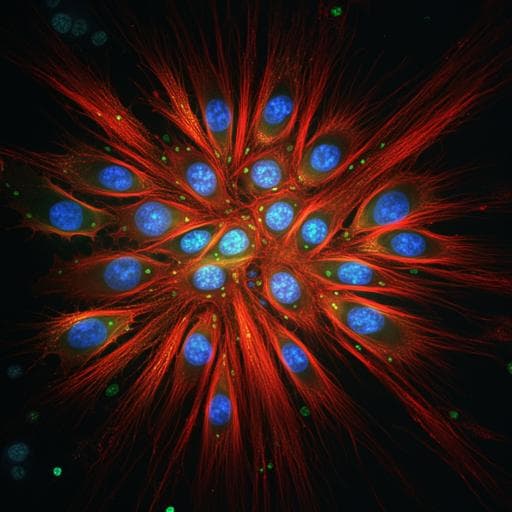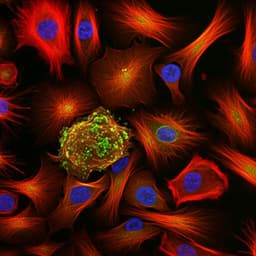
Veterinary Science
Single-cell T-cell receptor repertoire profiling in dogs
M. H. Hoang, Z. L. Skidmore, et al.
Discover how single-cell T-cell receptor sequencing (scTCRseq) provides insights into immune responses in dogs with cancer. This groundbreaking research, led by My H. Hoang and colleagues, reveals the diverse T-cell repertoires in healthy dogs and distinct profiles in those with T-cell lymphoma and melanoma, highlighting potential anti-tumor activity.
~3 min • Beginner • English
Introduction
Companion dogs with spontaneous cancers provide valuable translational models for human oncology due to shared environment, outbred genetics, and comparable physiology. Immunotherapy advances have heightened the need to profile T cell receptor (TCR) repertoires to understand, track, and predict T cell responses in cancer, as well as diagnose and monitor T cell malignancies. The tumor microenvironment can be immunosuppressive (e.g., cytokine-driven PD-L1 upregulation), making single-cell TCR profiling within this context especially informative. Despite increasing canine clinical trials, dog-specific molecular reagents—particularly for single-cell immune profiling—are limited. While a few canine scRNA-seq studies exist and proof-of-principle canine scTCRseq has been reported, comprehensive single-cell TCR profiling integrating scRNA-seq in client-owned dogs, including cancer samples from unsorted tissues, has not been demonstrated. This study addresses that gap by developing and validating canine TRA and TRB scTCR profiling compatible with 10x Genomics 5′ workflows and applying it to PBMCs and lymph node aspirates from healthy dogs and dogs with melanoma or T cell lymphoma to characterize TCR diversity, clonality, and phenotypes of expanded T cells.
Literature Review
Prior work underscores the translational relevance of canine cancer models and reports multiple immunotherapy trials in dogs. Single-cell studies in canine samples are few, and no commercial kits or standardized protocols for canine scTCRseq on popular platforms (e.g., 10x Chromium) were available. Earlier studies provided proof-of-principle for canine scTCRseq and an atlas of sorted TCRαβ+ T cells from healthy experimental dogs, but comprehensive scTCRseq of client-owned dogs, unsorted tissues, or cancers was not shown. Literature on the tumor microenvironment highlights immunosuppressive mechanisms (e.g., IL-6, IL-12, TGFβ effects on PD-L1) relevant to T cell function and immunotherapy response. Collectively, these studies motivate single-cell TCR profiling in dogs, particularly integrated with transcriptomics to pair TCR chains and infer activation/exhaustion states, and to improve TCR–neoantigen–MHC prediction algorithms.
Methodology
Study design and samples: 16 single-cell suspensions from 11 client-owned dogs were profiled: five healthy dogs (PBMC and lymph node aspirates each; 10 samples), four dogs with metastatic melanoma (PBMCs; 4 samples), and two Golden Retrievers with T cell lymphoma (lymph node aspirates; 2 samples: T-zone lymphoma and PTCL-NOS). Flow cytometry characterized lymphocyte subsets in normal samples and T-zone lymphoma. Ethical approval: University of Missouri ACUC protocol #30721.
Single-cell library prep: 10x Genomics 5′ scRNA-seq chemistry (v1 and Next GEM 5′ v2 kits) was used. Cells were processed to generate 10x barcoded full-length cDNA. For scTCR enrichment, a nested PCR design was implemented using dog-specific reverse primers in TCR constant regions (TRA and TRB) while retaining 10x forward primers targeting the R1 adapter. Outer and inner reverse primers annealed to C regions. Primer design used representative canine TCR α (GenBank M97511.1) and β (HE653957.1) sequences extended with 10x adapter, barcode, UMI, TSO, and V(D)JC regions, and designed with Primer3Plus. PCR used Phusion polymerase with specified cycling (outer: 12 cycles, 98/65/72 °C; inner: identical but 62 °C annealing) and SPRI bead cleanups.
Library construction and sequencing: TCR-enriched products and set-aside scRNA cDNA were converted to Illumina libraries per 10x protocols. Sequencing was on NovaSeq 6000 S4, 2×151 bp. Targets: ~25 M read pairs per V(D)J library and ~500 M per scRNA library; observed V(D)J libraries averaged ~188 M reads (range ~87–237 M) due to sequencing practices.
Data processing: Cell Ranger v5.0.1 was used. A canine scRNA reference (CanFam3.1, Ensembl v102) was built with cellranger mkref/mkgtf. A canine V(D)J reference was built with fetch-imgt and cellranger mkvdjref; missing C-region sequences (TRAC, TRBC isoforms) were manually added. scRNA: cellranger count and aggregate; filters removed cells with <100 genes, genes in <10 cells, high mitochondrial fraction (top 5%), and doublets (DoubletFinder v2.0.3). scTCR: cellranger vdj assembled contigs and called clonotypes (defined by one or more TRA/TRB CDR3s). Additional analyses used Loupe Browser/VDJ and R (Seurat 4.3.0; ggplot2; dplyr; etc.).
Cell typing and differential expression: SingleR with signatures mapped from Haemopedia/DMAP (human-to-dog orthologs via Ensembl v102) annotated cell types. CD8+ T cells were categorized as expanded if clonotype frequency >1% of cells; otherwise non-expanded. Differential expression between expanded vs non-expanded CD8+ T cells tested known activation (CD38, GZMA, GZMK, MKI67) and exhaustion markers (CTLA4, HAVCR2, NFATC1, NR4A1/2/3, PDCD1, PRDM1, TCF7, TIGIT, TOX, TOX2) with Wilcoxon test and Bonferroni correction (adjusted p<0.05). Effector-memory (CCL5, ZEB2, GZMK) and naive (LEF1, TCF7, CCR7) markers assessed.
Sequencing metrics: V(D)J libraries averaged 4,863 estimated V(D)J-expressing cells (range 1,850–8,000), 42,312 mean reads/cell (26,772–86,352), 83.3% mean fraction reads in cells, 14.2 median UMIs/cell, and 2,706 median reads/UMI per clonotype. Reads mapped to any V(D)J gene: mean 78.9%. TRA mapped reads 32.2%, TRB 46.5%. Productive TRA in 45.2–96.9% (median 83.3%) of cells; productive TRB in 83.5–99.6% (median 97.6%); productive paired TRA+TRB in 34.9–95.3% (median 80.6%). Unique clonotypes per sample averaged 3,498 (348–5,971). v2 kits improved TRA/TRB pairing relative to v1. scRNA libraries estimated 6,968–9,600 cells, 19,952–72,253 reads/cell, 67.1–73.4% reads mapped to genome, 14,090–14,751 genes detected/sample, and 1,162–1,635 median genes/cell.
Statistical considerations: Clonotype diversity assessed via Inverse Simpson Index. To control for unequal cell numbers, clonotype distributions were downsampled to 1,850 T cells across 100 permutations, confirming cohort-level diversity patterns.
Key Findings
- Successfully developed and validated canine-specific scTCRseq integrated with scRNA-seq across 16 samples from 11 dogs, yielding 77,809 V(D)J-expressing cells and 55,973 clonotypes from ~3.0 billion reads.
- Gene segment coverage: observed 85.3% (29/34) of functional TRAV, 100% (40/40) TRAJ, 100% (22/22) TRBV, and 100% (9/9) TRBJ segments. Also detected expression of pseudogene and non-functional ORF segments, often at low frequency but sometimes abundant.
- Pairing and productivity: Median 80.6% of cells had a productive paired TRA/TRB; median productive TRA 83.3% and TRB 97.6%. v2 10x kits showed markedly better TRA/TRB pairing (median 69.8% paired) than v1 (30.9%), with fewer TRA-only/TRB-only clonotypes.
- Repertoire diversity and clonality by cohort:
• Healthy controls: Highly diverse, near absence of clonal expansion. Healthy lymph nodes: top clonotype ~0.09% of cells; mean diversity (Inverse Simpson) 4,470.9; ~4,562 unique clonotypes from ~4,642 V(D)J cells. Healthy PBMCs: top clonotype ~0.91%; diversity 3,128.4; ~4,910 unique clonotypes from ~5,320 cells.
• T cell lymphomas: Markedly clonal. T-zone lymphoma and PTCL-NOS had dominant clonotypes comprising 88.0% and 89.2% of cells; diversities 1.28 and 1.26; unique clonotypes 348 and 562 from 8,000 and 6,649 cells, respectively.
• Melanoma PBMCs: Oligoclonal with a few dominant clonotypes; top clonotype averaged 9.2% (range 3.5–14.5%); diversity 132.7 (19.4–390.6); mean 1,925 unique clonotypes from 3,338 cells. Dominant clonotypes predominantly CD8+.
- CD8+ T cell phenotypes: In melanoma PBMCs, expanded CD8+ clonotypes showed increased activation markers (GZMA, GZMK, CD38) and decreased exhaustion-related markers (CTLA4, TOX, NFATC1) versus non-expanded CD8+ cells (adjusted p<0.05). Expanded CD8+ cells mainly displayed effector-memory signatures (CCL5, ZEB2, GZMK); non-expanded cells were predominantly naive (LEF1, TCF7, CCR7). In T-zone lymphoma, the expanded clone was largely CD8+ and exhibited naive markers, suggesting expansion without maturation.
- Pseudogene/ORF re-annotation evidence:
• TRAV9-2 (labeled pseudogene in IMGT) produced many productive clonotypes across dogs; sequence analysis supports an alternate functional consensus aligning to newer dog assemblies and wolf/Labrador sequences, suggesting IMGT/Boxer reference may be incorrect or rare.
• TRBV19 pseudogene usage in one dog (Normal_E) explained by a germline T→C variant converting a stop to Q, enabling productivity.
• TRBJ1-3 (pseudogene) widely used in productive clonotypes across all dogs; V–J junctional changes commonly eliminate the annotated stop, including a massively dominant TRBV26::TRBJ1-3 clone in T-zone lymphoma (95.2% of cells).
• Frequent productive usage of ORF segments TRAJ52, TRBV15, and TRBJ1-4 suggests re-annotation to functional may be warranted.
- Additional repertoire characteristics: Median observed V(D)J contig lengths ~501 nt (TRA) and ~511 nt (TRB); median CDR3 length 14 aa for both chains. Germline variability observed with a mean of ~26.8 alternate allele sequences per sample across TRAV/TRBV genes.
Discussion
This study establishes a practical, dog-specific scTCRseq protocol compatible with 10x 5′ workflows and demonstrates its utility by profiling healthy, melanoma, and T cell lymphoma samples. The data confirm that healthy dogs possess highly diverse, largely polyclonal TCR repertoires, whereas T cell lymphomas are dominated by a single malignant clone. Vaccine-treated melanoma PBMCs exhibit oligoclonal expansions, primarily within CD8+ T cells that show transcriptional signatures of activation and effector-memory, consistent with anti-tumor activity in the context of immunotherapy. Integration of scTCRseq with scRNA-seq validated that V(D)J-expressing cells overlap with CD3E+ T cell clusters and CD4/CD8 annotations, enabling phenotypic characterization of expanded versus non-expanded clonotypes.
The extensive use of certain segments annotated as pseudogene or non-functional ORF, combined with sequence analyses revealing germline corrections and junctional edits that obviate stops, suggests that current IMGT annotations for several canine segments (e.g., TRAV9-2, TRBJ1-3, possibly TRBV19; and ORFs TRAJ52, TRBV15, TRBJ1-4) warrant re-evaluation. The findings highlight substantial germline diversity not fully represented in current references, with implications for accurate repertoire annotation and TCR–neoantigen predictions. Technical results also show improved TRA/TRB pairing and biologically plausible dual TCR rates with 10x 5′ v2 kits, informing best practices for future canine scTCR studies.
Overall, these results address the reagent gap for canine single-cell immune profiling, support the relevance of canine models for human immuno-oncology, and provide a framework to track tumor-reactive T cells and T cell malignancies at single-cell resolution.
Conclusion
The authors developed and validated canine-specific scTCRseq for 10x 5′ chemistries and integrated it with scRNA-seq to profile TCR repertoires in healthy dogs and dogs with melanoma or T cell lymphoma. They detected nearly all known functional V/J segments, identified substantial clonotype diversity in healthy samples versus dominant expansions in lymphomas and oligoclonal expansions in melanoma PBMCs, and showed that expanded CD8+ clonotypes exhibit activation and effector-memory phenotypes consistent with anti-tumor responses during immunotherapy. Sequence analyses support re-annotation of several pseudogene/ORF segments (TRAV9-2, TRBJ1-3, possibly TRBV19; and TRAJ52, TRBV15, TRBJ1-4) as functional or conditionally functional.
Future directions include: expanding protocols to additional TCR loci (TRD, TRG) and BCR sequencing; comprehensive germline analysis with modern canine genomes to refine gene segment annotations and alleles; applying these methods longitudinally in canine immunotherapy trials to link TCR dynamics and phenotypes with clinical outcomes; and continued optimization using 10x 5′ v2 kits and improved clonotype clustering/merging tools.
Limitations
- Platform constraint: Protocols are limited to 10x Genomics 5′ chemistries (v1/v2) and are not readily adaptable to 3′ GEX, Multiome, or other 3′ approaches.
- Sampling and detection: Total cells profiled (~77.8k) and presence of dominant clones in some samples may reduce sensitivity to rare clonotypes and contribute to missing a subset of functional TRAV segments (e.g., TRAV8-1, TRAV9-4, TRAV19, TRAV23, TRAV43-3).
- Reference limitations: IMGT canine references (largely CanFam3.1/6) may contain errors or lack common alleles; D gene segments were not reported due to mapping difficulty. Re-annotation proposals require validation with genomic DNA and broader breed representation.
- Cohort size and data breadth: 11 dogs total; scRNA-seq performed for 5 samples (4 melanoma PBMCs and 1 T-zone lymphoma), with no scRNA for PTCL-NOS. Flow cytometry and detailed phenotyping not available for all cases.
- Technical variability: 10x v1 versus v2 kit differences affected TRA/TRB pairing; sequencing depth exceeded nominal recommendations, potentially affecting metric comparability across studies.
Related Publications
Explore these studies to deepen your understanding of the subject.







